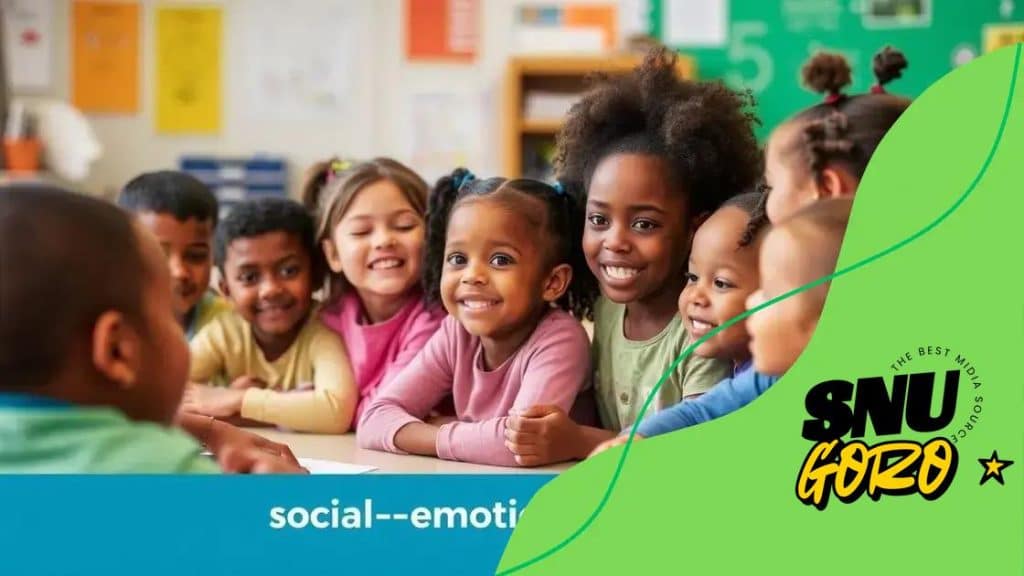Social-emotional learning integration strategies that work

Engaging parents in social-emotional learning (SEL) enhances children’s emotional and social skills by fostering communication, providing resources, and encouraging active participation in school activities.
Social-emotional learning integration strategies can transform how students interact and develop essential life skills. Have you ever wondered how fostering emotional intelligence influences learning? Let’s dive into the strategies that can make a real difference.
Understanding social-emotional learning
Understanding social-emotional learning is crucial for creating a positive learning environment. It encompasses the skills students need to manage emotions, build relationships, and make responsible decisions. By integrating social-emotional learning into education, teachers can help enhance overall student well-being.
What is Social-Emotional Learning?
Social-emotional learning (SEL) involves teaching students essential skills related to their emotions and interactions. These competencies are not only vital for academic success but also for personal growth.
Key Competencies of SEL
- Self-awareness: Recognizing one’s own emotions and values.
- Self-management: Controlling impulses and managing stress effectively.
- Social awareness: Understanding diverse perspectives and showing empathy towards others.
- Relationship skills: Building healthy relationships and communicating effectively.
These components are interrelated, forming a foundation for personal and academic achievement. By focusing on these areas, educators can help students develop healthier life skills.
Additionally, implementing SEL strategies can lead to improved classroom behavior and reduced emotional distress among students. Teachers employing SEL integration often notice increased engagement and better academic performance.
Benefits of SEL
The benefits of integrating social-emotional learning are vast. Research shows that students with strong social-emotional skills perform better academically. They are also more likely to engage positively with their peers and exhibit resilience when facing challenges.
Moreover, such education helps to cultivate emotional intelligence, critical for future workplace success. By emphasizing these skills early, we prepare students not just for school, but for life.
Emphasizing social-emotional learning in schools fosters safer and more supportive learning environments. When teachers prioritize SEL, they create spaces where students feel valued, respected, and understood.
Key benefits of integration strategies
Implementing integration strategies for social-emotional learning (SEL) offers numerous benefits. These strategies help create a supportive environment that nurtures both emotional and academic growth. Schools that adopt these methods often see positive changes in student behavior and engagement.
Improved Academic Performance
One of the most significant advantages of SEL integration is improved academic performance. When students develop strong emotional skills, they are more equipped to handle school challenges. Research shows that students who engage in SEL programs tend to score higher in tests and assignments.
Enhanced Social Skills
Social-emotional learning strategies also enhance students’ social skills. Through teamwork and collaboration, students learn to communicate effectively and resolve conflicts peacefully. This growth fosters a sense of community among peers.
- Fostering empathy: Students who practice SEL become more empathetic, understanding the feelings and perspectives of others.
- Building meaningful relationships: SEL encourages students to form positive relationships that last beyond the classroom.
- Encouraging teamwork: Collaborative activities emphasize working together and valuing each other’s contributions.
By nurturing these skills, schools create a more harmonious environment for learning. Students not only excel academically but also thrive socially.
Additionally, integrating SEL practices helps manage classroom behavior. When students understand their emotions, they are less likely to act out. This leads to a more focused learning atmosphere, benefiting everyone involved.
Long-Term Emotional Well-Being
The long-term emotional benefits of SEL are tremendous. Students equipped with social-emotional skills tend to have better mental health as they grow older. They learn to cope with stress and challenges effectively, making them more resilient.
Moreover, these skills are fundamental for future success. As students transition to adulthood, their ability to navigate social dynamics and maintain emotional health becomes crucial. Schools that prioritize SEL not only prepare students for immediate success but also for lifelong learning and well-being.
Effective classroom practices for SEL

Effective classroom practices for social-emotional learning (SEL) are essential in building students’ emotional and social skills. These practices create a positive atmosphere where students feel safe and valued. When teachers incorporate SEL techniques, they can enhance student engagement and overall well-being.
Creating a Safe Environment
One of the first steps in promoting SEL is establishing a safe and welcoming classroom environment. It is vital that students feel comfortable expressing themselves. Teachers can achieve this by fostering open communication and showing empathy toward students’ feelings.
Incorporating Collaborative Activities
Collaborative activities are key in enhancing social skills. When students work together, they develop important skills like communication and teamwork. Group projects or pair activities can encourage students to share their thoughts openly and learn to respect differing opinions.
- Group discussions: Holding regular discussions where all voices are heard helps students express their emotions and ideas.
- Peer feedback: Encouraging students to give and receive feedback can help them build constructive relationships.
- Conflict resolution exercises: Teaching students how to manage conflicts prepares them for real-world interactions.
Additionally, integrating SEL into daily routines is crucial. Simple practices like morning meetings or check-in circles can foster connections among students, allowing them to share their feelings and thoughts.
Using Reflective Practices
Reflective practices are another powerful tool for SEL in the classroom. Encouraging students to think about their feelings and actions can lead to improved self-awareness. Journaling or sharing reflections can help students process their emotions and develop critical thinking skills.
Furthermore, teachers can model emotional intelligence by sharing their experiences and how they manage challenges. This approach helps students understand that everyone faces difficulties and that it is okay to seek support.
By implementing these effective practices, educators can significantly impact students’ social-emotional development, paving the way for improved academic outcomes and healthier relationships.
Assessing the impact of SEL strategies
Assessing the impact of social-emotional learning (SEL) strategies is vital for understanding their effectiveness. By evaluating how these strategies influence student behavior and academic performance, educators can make informed decisions for future improvements. Assessment provides insights into what works best in the classroom.
Methods for Assessment
There are several methods for assessing the impact of SEL strategies. Teachers can use various tools to gather data on student progress. Surveys, observations, and standardized tests are common methods that provide valuable information.
Surveys and Questionnaires
Surveys can measure students’ emotional well-being and social skills. A well-designed survey can capture important feedback on how students feel about their school environment. This information helps educators understand the emotional landscape of their classrooms.
- Student self-report surveys: These allow students to express their thoughts and feelings.
- Teacher assessments: Observations from teachers can provide insights into student interactions and behaviors.
- Parent feedback: Engaging parents through surveys can help understand the impact of SEL outside of school.
Analyzing this data helps create baseline measurements and track improvement over time. Teachers can adapt their practices based on what the data reveals.
Observational Techniques
Observational techniques are also essential in assessing SEL effectiveness. Teachers can observe student interactions and behaviors to see how well they apply SEL skills in real-life situations. Documenting instances where students successfully resolve conflicts or support peers can illustrate the benefits of SEL integration.
Additionally, monitoring classroom dynamics, such as participation and engagement levels during lessons, can show the influence of SEL strategies. When students feel supported emotionally, they often participate more actively in class.
Furthermore, standardized assessments can provide quantitative data to compare students’ performance before and after implementing SEL strategies. These assessments can indicate significant developments in academic performance related to social-emotional skills.
In summary, assessing the impact of SEL strategies through diverse data collection methods shows their value in education. By measuring their effectiveness, educators can refine and enhance SEL programs to meet students’ needs better. This ongoing evaluation is crucial for cultivating a positive learning environment.
Engaging parents in the SEL process
Engaging parents in the social-emotional learning (SEL) process is essential for reinforcing skills at home. When parents are involved, children receive consistent messages about managing emotions and building relationships. This partnership can greatly enhance the effectiveness of SEL strategies in schools.
Building Strong Communication
Establishing clear and regular communication with parents is fundamental. Schools can create channels, such as newsletters or meetings, to share information about SEL initiatives. This helps parents understand the SEL concepts being taught and how to support them.
Providing Resources for Parents
Schools should provide resources to parents that offer strategies and activities they can do at home. These resources may include guides on how to discuss emotions with children or activities that promote social skills. Engaging parents with tools can bridge the gap between school and home.
- Workshops: Hosting parent workshops can educate them about SEL and its importance.
- Monthly newsletters: Sending newsletters with tips and book recommendations can keep parents informed.
- Online resources: Sharing websites with SEL activities allows parents to practice skills with their kids.
Additionally, facilitating parent-teacher conferences focused on SEL offers a platform for discussing specific strategies that can be implemented at home. These discussions can empower parents to take an active role in their child’s social-emotional development.
Encouraging Parent Participation
Encouraging parents to participate in school activities related to SEL can foster a sense of community. This involvement not only strengthens bonds among parents and teachers but also demonstrates that emotional and social growth is a priority for everyone involved.
Parents can be invited to share their experiences or teach skills related to their professions. This not only engages them but also enriches the learning environment for students. When parents can share their successes and challenges, it promotes a collaborative culture.
Moreover, schools can organize events that highlight SEL skills, such as family nights focused on teamwork or empathy-building exercises. Such events allow families to experience SEL firsthand and reinforce the skills taught at school.
In conclusion, engaging parents in the social-emotional learning (SEL) process is crucial. When parents actively participate, they reinforce the skills their children learn in school. This collaboration builds a supportive environment that benefits everyone. By fostering strong communication, providing useful resources, and encouraging participation, schools can create a thriving community focused on emotional and social growth. Overall, the partnership between parents and educators plays a vital role in enhancing students’ success and well-being.
FAQ – Frequently Asked Questions about Engaging Parents in the SEL Process
Why is parental involvement important in SEL?
Parental involvement reinforces the skills children learn in school, creating a consistent message about social-emotional development.
How can schools effectively communicate with parents about SEL?
Schools can use newsletters, meetings, and workshops to keep parents informed about SEL initiatives and their importance.
What resources can schools provide to help parents support SEL at home?
Schools can offer guides, activity suggestions, and online resources for parents to practice SEL skills with their children.
What are some ways to encourage parent participation in SEL events?
Inviting parents to share experiences, organizing family nights, and involving them in school activities can boost their participation in the SEL process.





